Birçok WordPress kullanıcısı, bilgisayarlarında yerel bir sunucu kullanarak web siteleri üzerinde çalışmayı tercih eder. Bu, değişiklikleri çevrimiçi olarak kullanıma sunmadan önce web siteniz üzerinde özel olarak çalışmanıza olanak tanır.
Sonunda, çevrimiçi ziyaretçilerin erişimine açmak için web sitenizi canlı bir sunucuya taşımanız gerekecektir. Bu geçiş, web sitenizin canlı sitede düzgün çalışmasını sağlamak için çok önemlidir.
Birçok yerel web sitesi üzerinde çalıştık, bu nedenle içeriği canlı web sitelerine aktarmanın en kolay yolunu öğrenmemiz gerekiyordu.
Bu makalede, WordPress’in yerel bir sunucudan canlı bir siteye nasıl taşınacağına ilişkin adım adım talimatlar vereceğiz.
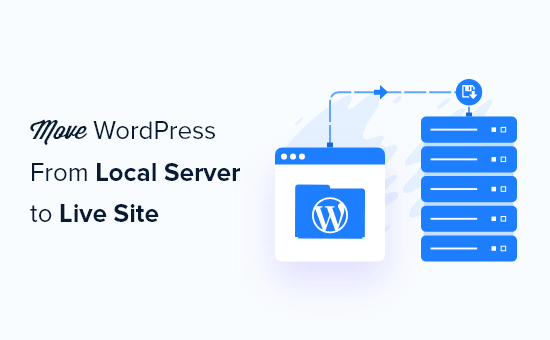
WordPress’i Neden Yerel Sunucudan Canlı Siteye Taşımalısınız?
WordPress blogunuzu yerel bir sunucuda oluşturmak, web sitenizdeki değişiklikleri ziyaretçileri etkilemeden test etmenin güvenli bir yoludur.
Web sitenizi mükemmelleştirmeyi tamamladığınızda, bir sonraki adım yerel sunucunuzdan canlı bir siteye geçmektir.
Sitenizi yerel bir sunucudan canlı bir siteye taşımanın iki yolunu gösterelim.
İlk yöntem bir WordPress geçiş eklentisi kullanır ve yeni başlayanlar için önerilir.
İkinci yöntemde, WordPress’i yerel bir sunucudan canlı bir siteye manuel olarak nasıl taşıyacağınızı göstereceğiz.
Sizin için en uygun olan yöntemi seçebilirsiniz:
WordPress Sitenizi Taşımadan Önce
WordPress’i yerel bir sunucudan canlı bir sunucuya taşımak için birkaç şeye sahip olmanız gerekir.
İlk olarak, bilgisayarınızdaki yerel bir sunucuda (localhost olarak da adlandırılır) çalışan bir WordPress siteniz olduğunu ve buna tam erişiminiz olduğunu varsayıyoruz.
Ardından, bir alan adına ve web barındırma hizmetine sahip olmanız gerekir.
Kötü veya ücretsiz web barındırma sağlayıcılarıyla başlayıp pişman olan yeni başlayanlardan sayısız hikaye duyduk. Deneyimlerimize göre, doğru barındırma sağlayıcısını seçmek herhangi bir web sitesinin başarısı için kritik öneme sahiptir.
Kararınızı kolaylaştırmak için Bluehost kullanmanızı öneririz. Resmi olarak önerilen bir WordPress barındırma şirketidir ve WPBeginner kullanıcılarına özel bir indirim + ücretsiz alan adı ve SSL veriyorlar.
Temel olarak, ayda 1,99 $ gibi düşük bir ücretle başlayabilirsiniz.
Harika bir Bluehost alternatifi istiyorsanız, Hostinger‘a bakabilirsiniz. Ayrıca WPBeginner kullanıcılarına ücretsiz bir alan adı ile özel bir indirim sunuyorlar.
Biraz daha fazla ödemeyi göze alabiliyorsanız, SiteGround‘a göz atın. Ayrıca WPBeginner okuyucuları için özel bir fırsatları var.
Web sitenizi kurmak için yardıma ihtiyacınız varsa, bir web sitesinin nasıl yapılacağına ilişkin adım adım kılavuzumuzu izleyin.
Son olarak, bir FTP programına ihtiyacınız olacak ve yerel sunucu sitenizi canlı siteye yüklemek için FTP’yi nasıl kullanacağınızı bileceksiniz.
Hazır mısınız? WordPress sitenizi taşımaya başlayalım.
Video Eğitimi
Yazılı talimatları tercih ediyorsanız, okumaya devam edin.
Yöntem 1: Bir Geçiş Eklentisi Kullanarak WordPress’i Yerel Sunucudan Canlı Siteye Aktarın (Önerilen)
Bu yöntem daha kolaydır ve yeni başlayanlar için önerilir. WordPress’i localhost’tan canlı bir siteye taşımak için bir WordPress migration eklentisi kullanacağız.
Adım 1: Duplicator Eklentisini Kurun ve Ayarlayın
Öncelikle, yerel sitenize Duplicator eklentisini yüklemeniz ve etkinleştirmeniz gerekir. Daha fazla ayrıntı için, bir WordPress eklentisinin nasıl kurulacağına ilişkin adım adım kılavuzumuza bakın.
Profesyonelİpucu: Duplicator ‘ın güvenli yedeklemeler, bulut depolama, kolay site geri yükleme ve daha fazlasını sunan profesyonel bir sürümü de vardır.
Etkinleştirmenin ardından, Duplicator ” Yedeklemeler sayfasına gitmeniz ve ‘Yeni Oluştur’ düğmesine tıklamanız gerekir.
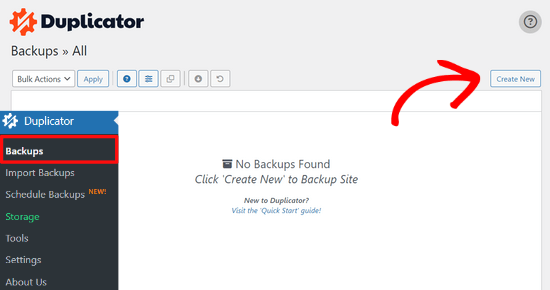
Bu sizi yedeklemenize bir ad verebileceğiniz bir ekrana getirir.
Ardından, ‘İleri’ düğmesine tıklayın.

Duplicator şimdi her şeyin yolunda olup olmadığını görmek için bazı testler yapacaktır.
Tüm öğeler ‘İyi’ olarak işaretlenmişse, ‘Oluştur’ düğmesine tıklayın.

Bu işlem, web sitenizin boyutuna bağlı olarak birkaç dakika sürebilir. İşlem tamamlanana kadar bu sekmeyi açık bırakmalısınız.
Tamamlandığında, ‘Yükleyici’ ve ‘Arşiv’ paketleri için indirme seçenekleri göreceksiniz. Her iki dosyayı da bilgisayarınıza indirmek için ‘Her İki Dosyayı da İndir’ düğmesine tıklamanız gerekir.

‘Arşiv’ dosyası WordPress sitenizin eksiksiz bir kopyasıdır. Tüm WordPress çekirdek dosyalarının yanı sıra resimlerinizi, yüklemelerinizi, temalarınızı, eklentilerinizi ve WordPress veritabanınızın bir yedeğini içerir.
‘Yükleyici’ dosyası, web sitenizi içeren arşiv dosyasını açarak tüm geçiş sürecini otomatikleştirecek bir komut dosyasıdır.
Adım 2: Canlı WordPress Web Siteniz İçin Bir Veritabanı Oluşturun
Yükleyiciyi çalıştırmadan veya WordPress web sitesini localhost’tan hosting sunucunuza yüklemeden önce, yeni canlı web siteniz için bir MySQL veritabanı oluşturmanız gerekir.
Zaten bir MySQL veritabanı oluşturduysanız, bu adımı atlayabilirsiniz.
Bir veritabanı oluşturmak için hosting hesabınızın cPanel kontrol panelini ziyaret etmeniz gerekir. Ardından, ‘Veritabanları’ bölümünü bulun ve ‘MySQL Veritabanı Sihirbazı’ simgesine tıklayın.
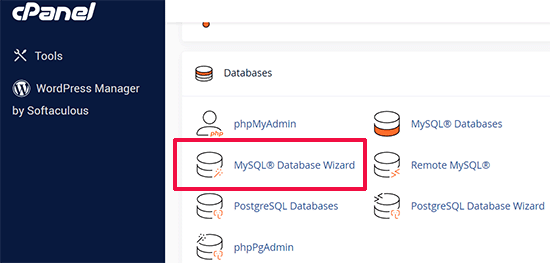
Bir sonraki ekranda, yeni bir veritabanı oluşturmak için bir alan vardır.
Veritabanınız için bir ad girin ve ‘Veritabanı Oluştur’ düğmesine tıklayın.

cPanel şimdi sizin için yeni bir veritabanı oluşturacaktır.
Bundan sonra, yeni kullanıcınız için bir kullanıcı adı ve şifre girmeniz ve ardından ‘Kullanıcı Oluştur’ düğmesine tıklamanız gerekir.
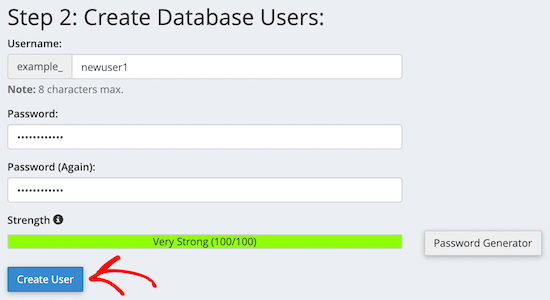
Ardından, yeni oluşturduğunuz kullanıcıyı veritabanına eklemeniz gerekir.
İlk olarak, ‘Tüm Ayrıcalıklar’ onay kutusunu tıklayın.
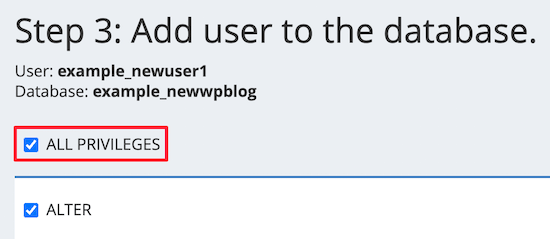
Ardından, aşağı kaydırın ve değişikliklerinizi kaydetmek için ‘Değişiklik Yap’ düğmesine tıklayın.
Veritabanınız artık WordPress sitenizle birlikte kullanılmaya hazırdır. Veritabanı adını, kullanıcı adını ve parolayı not ettiğinizden emin olun. Bu bilgilere bir sonraki adımda ihtiyacınız olacak.
Adım 3: Dosyaları Yerel Sunucudan Canlı WordPress Web Sitesine Yükleyin
Şimdi, arşiv ve yükleyici dosyalarını yerel sitenizden barındırma hesabınıza yüklemeniz gerekir.
İlk olarak, bir FTP istemcisi kullanarak canlı sitenize bağlanın. Bağlandıktan sonra, web sitenizin kök dizininin tamamen boş olduğundan emin olun.
Normalde kök dizin /home/public_html/ klasörüdür.
Bazı WordPress barındırma şirketleri, kaydolduğunuzda WordPress’i otomatik olarak yükler. Eğer orada WordPress dosyalarınız varsa, onları silmeniz gerekir.
Bundan sonra, archive.zip ve installer.php dosyalarını Duplicator’dan boş kök dizininize yükleyebilirsiniz.

Adım 4: Geçiş Komut Dosyasını Çalıştırma
Geçiş dosyalarını yükledikten sonra, tarayıcınızda aşağıdaki URL’yi ziyaret etmeniz gerekir:
http://example.com/installer.php
‘example.com’ yerine kendi alan adınızı yazmayı unutmayın.
Bu, Duplicator geçiş sihirbazını başlatacaktır.
Yükleyici birkaç test çalıştıracak ve komut dosyasını başlatacaktır.
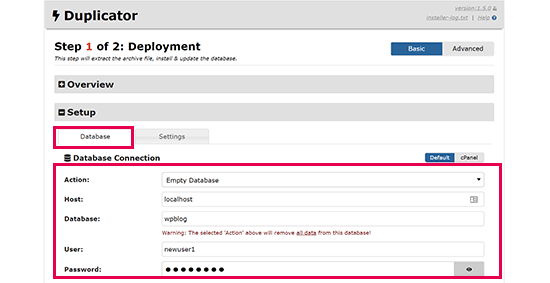
Kurulum bölümü altında, MySQL ana bilgisayarınızı, veritabanı adınızı, kullanıcı adınızı ve şifrenizi girmeniz istenecektir.
Ana bilgisayarınız muhtemelen yerel bir ana bilgisayar olacaktır. Bundan sonra, bir önceki adımda oluşturduğunuz veritabanının ayrıntılarını gireceksiniz.
Ardından, girdiğiniz bilgilerin doğru olduğundan emin olmak için ‘Doğrula’ düğmesine tıklayın.
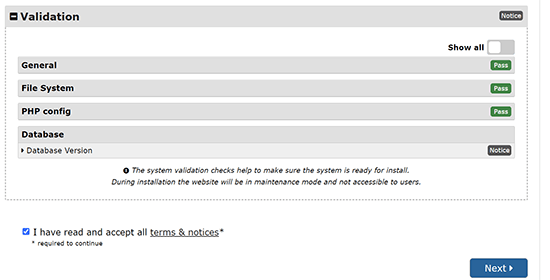
Bundan sonra, devam etmek için ‘İleri’ düğmesine tıklayın.
Duplicator şimdi WordPress veritabanı yedeğinizi arşivden yeni veritabanınıza aktaracaktır.
Ayrıca yerel siteye ve yeni canlı sitenize işaret eden URL’leri de güncelleyecektir.
Artık canlı sitenizin WordPress yönetici alanına girmek için ‘Yönetici Girişi’ düğmesine tıklayabilirsiniz.

Canlı sitenizde oturum açtığınızda, Duplicator kurulum dosyalarını otomatik olarak temizleyecektir.
Hepsi bu kadar. WordPress’i yerel sunucudan canlı sitenize başarıyla taşıdınız.
Yöntem 2: WordPress’i Yerel Sunucudan Canlı Siteye Manuel Olarak Aktarın
Bu yöntemde, WordPress’i yerel sunucudan canlı sitenize manuel olarak nasıl taşıyacağınızı göstereceğiz. İlk yöntem işe yaramazsa veya manuel olarak yapmayı tercih ederseniz faydalı olacaktır.
Adım 1: Yerel WordPress Veritabanını Dışa Aktarın
Yapmanız gereken ilk şey yerel WordPress veritabanınızı dışa aktarmaktır. Bunu yapmak için phpMyAdmin kullanacağız.
Eğer bu konuda bilginiz yoksa, phpMyAdmin kullanarak WordPress veritabanı yönetimi rehberimize göz atmak isteyebilirsiniz.
Basitçe http://localhost/phpmyadmin/ adresine gidin ve WordPress veritabanınıza tıklayın. Ardından, üst menü çubuğundan ‘Dışa Aktar’ düğmesine tıklayın.

‘Dışa aktarma yöntemi:’ seçeneğinde, ‘Hızlı’ veya ‘Özel’i seçebilirsiniz. Özel, veritabanınızı dışa aktarmak için size daha fazla seçenek sağlayacaktır.
Ancak veritabanınızı indirmek için ‘Hızlı’yı seçmenizi ve ardından ‘Git’ düğmesine tıklamanızı öneririz.

Adım 2: WordPress Dosyalarını Canlı Siteye Yükleyin
Şimdi, tüm web sitesi dosyalarınızı canlı siteye taşımamız gerekecek.
Başlamak için FTP istemcinizi açın ve web barındırma hesabınıza bağlanın.
Canlı sitenize bağlandıktan sonra, dosyaları doğru dizine yüklediğinizden emin olun. Örneğin, sitenin ‘yoursite.com’ adresinde barındırılmasını istiyorsanız, tüm dosyaları public_html dizininize yüklemek isteyeceksiniz.
Şimdi yerel WordPress dosyalarınızı seçin ve canlı sunucunuza yükleyin.
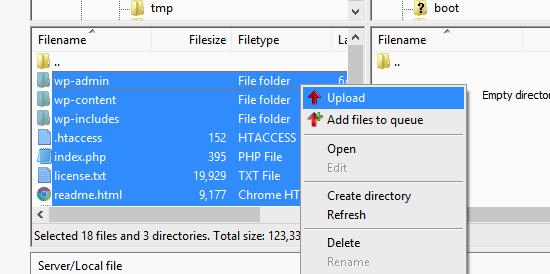
Adım 3: Canlı Sitenizde MySQL Veritabanı Oluşturun
FTP istemciniz WordPress dosyalarınızı yüklerken, veritabanınızı canlı sunucuya aktarmaya başlayabilirsiniz.
Çoğu WordPress barındırma sağlayıcısı, barındırma hesabınızı yönetmek için cPanel sunar, bu nedenle size cPanel kullanarak nasıl veritabanı oluşturacağınızı göstereceğiz.
Öncelikle, cPanel panonuza giriş yapmanız ve ‘Veritabanları’ bölümünde bulunan ‘MySQL Veritabanı Sihirbazı’ simgesine tıklamanız gerekir.

Bir sonraki ekranda yeni bir veritabanı oluşturabilirsiniz.
Veritabanınız için bir ad girmeniz ve ardından ‘Veritabanı Oluştur’a tıklamanız gerekir.

cPanel şimdi sizin için otomatik olarak yeni bir veritabanı oluşturacaktır.
Ardından, yeni kullanıcınız için bir kullanıcı adı ve şifre girmeniz ve ardından ‘Kullanıcı Oluştur’a tıklamanız gerekir.
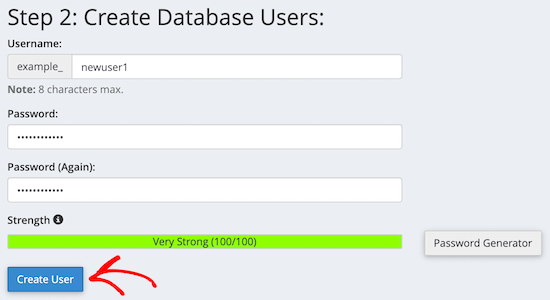
Bundan sonra, yeni oluşturduğunuz kullanıcıyı veritabanına eklemeniz gerekir.
İlk olarak, ‘Tüm Ayrıcalıklar’ onay kutusunu işaretleyin.
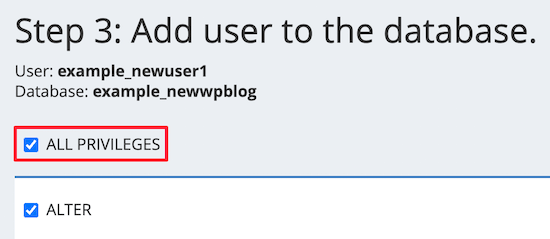
Ardından, aşağı kaydırın ve değişikliklerinizi kaydetmek için ‘Değişiklik Yap’a tıklayın.
Canlı WordPress siteniz için başarıyla yeni bir veritabanı oluşturdunuz.
Adım 4: WordPress Veritabanını Canlı Siteye Aktarın
Süreçteki bir sonraki adım WordPress veritabanınızı içe aktarmaktır.
cPanel panonuza gidin, ‘Veritabanları’ bölümüne ilerleyin ve ‘phpMyAdmin’e tıklayın.
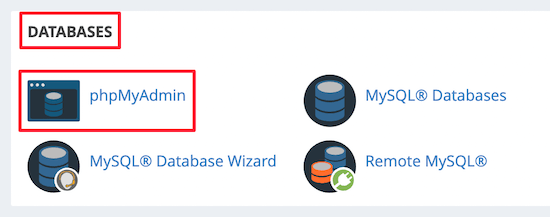
Bu sizi phpMyAdmin’e götürecektir, burada yukarıda oluşturduğunuz veritabanına tıklamak isteyeceksiniz. phpMyAdmin yeni veritabanınızı tablolar olmadan gösterecektir.
Ardından, üst menüdeki ‘İçe Aktar’ sekmesine tıklayın. İçe aktarma sayfasında, ‘Dosya Seç’ düğmesine tıklayın ve ardından ilk adımda kaydettiğiniz yerel sitedeki veritabanı dosyasını seçin.
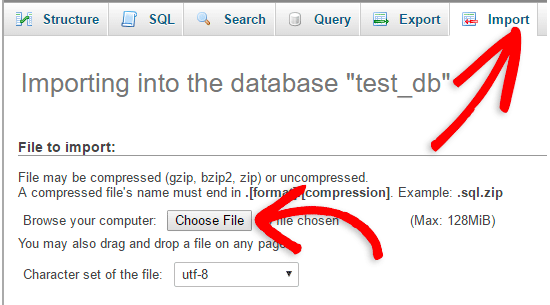
Bundan sonra, sayfanın altındaki ‘Git’ düğmesine tıklayın. Veritabanınız otomatik olarak phpMyadmin’e aktarılacaktır.
Adım 5: Site URL’sini Değiştirin
Şimdi, canlı WordPress sitenize bağlanması için veritabanınızdaki site URL’sini değiştirmeniz gerekir.
phpMyAdmin’de, yukarıda içe aktardığınız veritabanınızdaki wp_options tablosunu arayın.
Veritabanı önekinizi değiştirdiyseniz, wp_options yerine {new_prefix}_options olabilir.
Ardından, wp_options öğesinin yanındaki ‘Gözat’ düğmesine tıklayın. Ya da wp_options tablosundaki alanların bir listesini içeren sayfayı açmak için kenar çubuğundaki bağlantıya tıklayın.
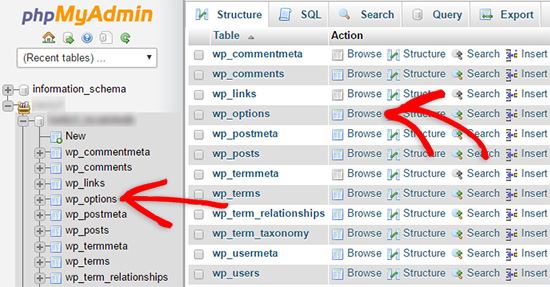
Ardından, options_name sütununda siteurl seçeneğini aramanız gerekir.
Ardından, ‘Düzenle’ simgesine tıklayın.

Bu, alanı düzenleyebileceğiniz bir pencere açar.
option_value giriş kutusunda, yerel yüklemenizin URL’sini göreceksiniz; bu URL http://localhost/test gibi bir şey olacaktır.
Bu alana yeni sitenizin URL’sini girmeniz gerekir, örneğin: https://www.wpbeginner.com.
Ardından, ‘Git’ düğmesine tıklayarak alanı kaydedebilirsiniz.
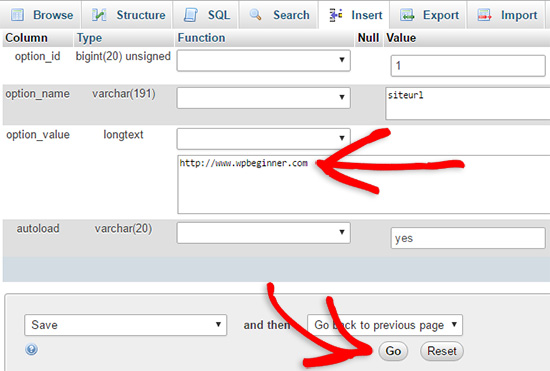
Ardından, ana sayfa seçeneği adı için yukarıdaki adımların aynısını izlemeniz gerekir. wp_options menüsü birkaç sayfa uzunluğunda olabilir. Genellikle, ana sayfa seçeneği ikinci sayfada olacaktır.
Ardından, ana sayfa URL’sini güncelleyin, böylece canlı site URL’nizle aynı olur.
Adım 6: Canlı Sitenizi Kurun
Veritabanını içe aktardığınıza ve içeriğinizi yüklediğinize göre sıra WordPress’i yapılandırmaya geldi.
Şu anda sitenizde‘Veritabanı bağlantısı kurulurken hata oluştu’ hatası görünüyor olmalıdır.
Bunu düzeltmek için, bir FTP istemcisi kullanarak web sitenize bağlanın ve wp-config.php dosyasını açın.
Aşağıdaki kod satırlarını arıyor olacaksınız:
1 2 3 4 5 6 7 8 9 | // ** MySQL settings - You can get this info from your web host ** ///** The name of the database for WordPress */define( 'DB_NAME', 'database_name_here' );/** MySQL database username */define( 'DB_USER', 'username_here' );/** MySQL database password */define( 'DB_PASSWORD', 'password_here' );/** MySQL hostname */define( 'DB_HOST', 'localhost' ); |
Daha önce oluşturduğunuz veritabanı adını, kullanıcı adını ve parolayı sağlamanız gerekecektir.
Ardından, wp-config.php dosyasını kaydedin ve WordPress barındırma sunucunuza geri yükleyin.
Şimdi, web sitenizi ziyaret ettiğinizde canlı olması gerekir.
Bundan sonra, WordPress yönetici panelinize giriş yapmanız ve Ayarlar ” Genel bölümüne gitmeniz gerekir. Ardından, hiçbir şeyi değiştirmeden en alta kaydırın ve ‘Değişiklikleri Kaydet’ düğmesine tıklayın.
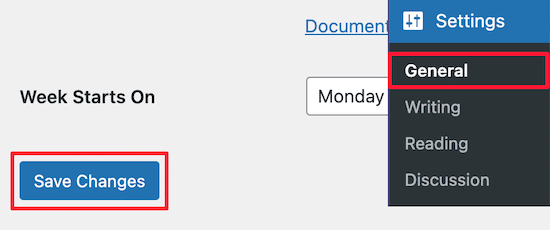
Bu, sitenizin URL’sinin olması gereken başka bir yerde düzeltilmesini sağlayacaktır.
Bunu yaptıktan sonra, Ayarlar ” Kalıcı Bağlantılar’a gidin, ardından aşağı kaydırın ve tüm gönderi bağlantılarının düzgün çalıştığından emin olmak için ‘Değişiklikleri Kaydet’e tıklayın.

Adım 7: Yolları Güncelleyerek Görüntüleri ve Bozuk Bağlantıları Düzeltin
Bir WordPress sitesini bir etki alanından diğerine veya yerel bir sunucudan canlı bir siteye taşıdığınızda, kırık bağlantılar ve eksik görüntülerle karşılaşırsınız.
URL’leri güncellemek için size iki yol göstereceğiz. Sizin için en uygun olanı seçebilirsiniz.
1. Search & Replace Everything Eklentisini Kullanarak URL’leri Güncelleyin (Önerilen)
Bunu düzeltmenin en güvenli yolu Search & Replace Everything kullanmaktır. Karmaşık veritabanı sorguları yazmadan web sitenizde toplu güncelleme görevlerini kolayca gerçekleştirmenizi sağlayan güçlü bir WordPress eklentisidir.
İlk olarak, Search & Replace Everything eklentisini yüklemeniz ve etkinleştirmeniz gerekir.
Etkinleştirmeden sonra Araçlar ” WP Search & Replace sayfasına gidin.
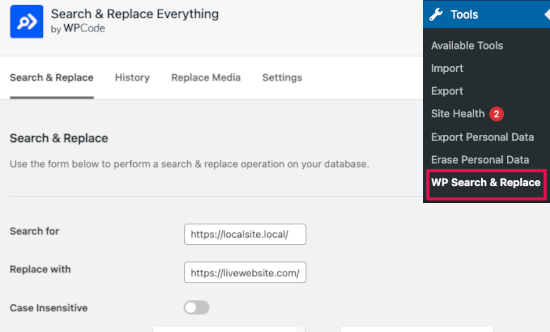
Buradan, yerel site URL’nizi ‘Ara’ alanına ve canlı site URL’nizi ‘Şununla değiştir’ alanına girmeniz gerekir.
Biraz kaydırın ve tabloların altındaki ‘Tümünü Seç’ seçeneğine tıklayın. Bu, eklentinin veritabanındaki her yerde eski URL’yi aramasını sağlar.

Şimdi devam etmek için ‘Arama ve Değiştirmeyi Önizle’ düğmesine tıklayın.
Eklenti, veritabanınızda eski URL’nin tüm örneklerini arayacak ve ardından sonuçları önizleyecektir.
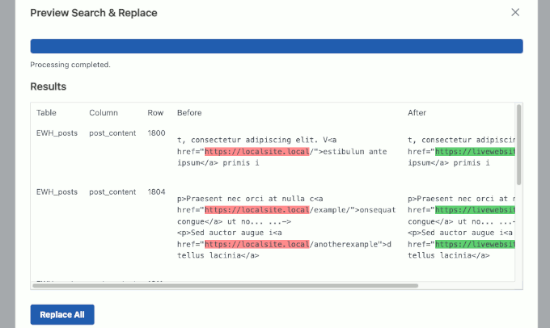
Her şey iyi görünüyorsa, değişiklikleri kaydetmek için ‘Tümünü Değiştir’e tıklayın.
Yaptığınız değişiklikler hakkında bir uyarı göreceksiniz. Devam etmek için ‘Evet’e tıklayın.
Eklenti şimdi veritabanını güncelleyecek ve yerel URL’leri mevcut web sitenizin URL’si ile değiştirecektir.
2. URL’leri Manuel Olarak Güncelleme (Gelişmiş)
URL’leri güncellemenin bir başka yolu da aşağıdaki SQL sorgusunu kullanmaktır:
1 | UPDATE wp_posts SET post_content = REPLACE(post_content, 'localhost/test/', 'www.yourlivesite.com/'); |
Basitçe phpMyAdmin‘e gidin, veritabanınıza tıklayın ve ardından üst menüden ‘SQL’e tıklayın ve yukarıdaki sorguyu ekleyin.
Yerel siteniz ve canlı site URL’leri olarak değiştirdiğinizden emin olun ve ‘Git’ düğmesine tıklayın.
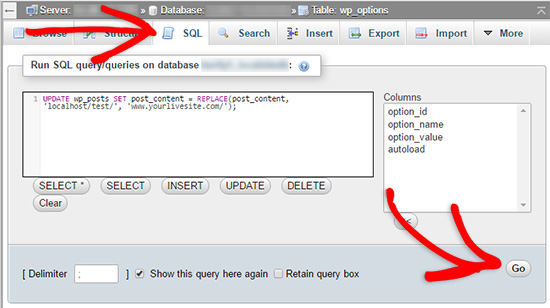
İşte bu kadar. Artık WordPress’i yerel sunucunuzdan canlı bir siteye başarıyla geçirdiniz.
Umarım canlı web siteniz sorunsuz bir şekilde çalışır. Herhangi bir hata fark ederseniz, sorun giderme konusunda yardım almak için yaygın WordPress hataları kılavuzumuza göz atabilirsiniz.
Umarız bu makale WordPress’i yerel bir sunucudan canlı bir siteye taşımanıza yardımcı olmuştur. Ayrıca canlı bir siteyi yerel bir sunucuya taşıma kılavuzumuzu görmek veya pratik WordPress taşıma adımları için nihai web sitesi taşıma kontrol listesine bakmak isteyebilirsiniz.
If you liked this article, then please subscribe to our YouTube Channel for WordPress video tutorials. You can also find us on Twitter and Facebook.





divine
Nice article,
Everything was go fine until the signing up on wordpress Admin, i’ve had d domain name for a long time and I can’t remember my wp-admin login details. What can I do to rectify this problem?
Secondly, I tried visiting my site, it opened but the site kept saying the page could not be found, I need help pls
monica
Hi there,
So, My site is runing and seems to work on the Lovalhost/mysite
DB connection is good, settes permalinks to default.
BUT:
all the links fo to the domain (live site) what I’m missing?
O.o
Thanks in advance, great tuto
rdllngr
Everything worked for me. Thanks a lot!
Alem
Helped me go live Thank you.
Thank you.
aqeel
hi plz help i am having this errer when i click import my database plz help
Error
SQL query:
—
— Database: `testword`
—
— ——————————————————–
—
— Table structure for table `wp_commentmeta`
—
CREATE TABLE IF NOT EXISTS `wp_commentmeta` (
`meta_id` BIGINT( 20 ) UNSIGNED NOT NULL ,
`comment_id` BIGINT( 20 ) UNSIGNED NOT NULL DEFAULT ‘0’,
`meta_key` VARCHAR( 255 ) COLLATE utf8mb4_unicode_ci DEFAULT NULL ,
`meta_value` LONGTEXT COLLATE utf8mb4_unicode_ci
) ENGINE = INNODB DEFAULT CHARSET = utf8mb4 COLLATE = utf8mb4_unicode_ci AUTO_INCREMENT =1;
MySQL said: Documentation
#1046 – No database selected
Prasanna
at the top of everything type USE ;
eg if my database name is wordpress then type
use wordpress;
Ngeshlew
Needless to say, you are the website that I always come to check whenever I want to migrate my local WordPress site to a live server.
Thank you guys for the easy steps.
Wafir Manakad
Hey,
Thanks a lot.
I had two queries:
1. On my new website (destination website), I am copying the old files onto an empty public html folder. That is the way right? There is no need to pre-install wordpress on new site?
2. Everything was fine right until the end. I am moving my website from one domain to another.
Finally when I open the new domain, part of the website loads, and partly there are errors. This is the error message:
Warning: include_once(/home/laprimaa/public_html/wp-content/themes/charlottetheme/charlottetheme/theme/plugin/advanced-customizer/lib/ctAdvancedCustomizerMethods.class.php) [function.include-once]: failed to open stream: No such file or directory in /home/laprimaa/public_html/wp-content/themes/charlottetheme/charlottetheme/framework/createit/ctFilesLoader.class.php on line 143
Does this mean I have not uploaded my files correctly?
Any help would be much appreciated.
Best Regards
sandeep kumar singh
how we can give the link of other page except home . i have given the url of home but by using your tutorial i have added post query but my site is not working till now .so please give me information to resolve this.
Shubhayan Ghoshal
Shouldn’t we be replacing the website name -> localhos/{dirname} for ‘guid’ column rather than post_content column?
justin
Okay everything was sailing smooth until I went to import the new database. Upon trying to import it it only puts in wp_commentmeta, wp_comments, wp_links, wp_options and then spits out the error code: ” #1064 – You have an error in your SQL syntax; check the manual that corresponds to your MySQL server version for the right syntax to use near ‘?’ at line 2 “. Now the whole site is down and I don’t have a clue what the heck it is referring too when it says “line 2”. Line 2 of what? And of course the Manual is so friggin helpful man I’ve never seen such helpful stuff (is there a way to type sarcastically?) Please help…
Frosty
Thanks mate. You are a diamond! Ran into a few problems, mainly 123 reg php address was incorrect but got there in the end.
Many many thanks
kathy
Hi, I am trying to import the database but appear to be getting an error. Any ideas anyone? I’m new to wordpress land.
WPBeginner Support
Can you please only paste the error line?
Admin
kathy
I’ve exported my local database and tried to import and it’s returning the below.
Database: `root_wordpress-trunk`
Table structure for table `wp_comments`
#1046 – No database selected
Any help would be greatly appreciated.
Rob
Hello,
I have migrated my site from local to host server. I followed all steps and everything went right but finnaly, I am missing content (posts, pages etc.). Does anybody has any advice?
Yosifov
Hallo, all worked nice so far, but I reached the step 5 where phpmyAdmin is not giving me the option to edit siteurl and home..
amin
thanks for this tutorial ,
I follow this steps and it work correctly i have domain and hosting from godaddy.
Adeel Ashraf
really awsome work (Y)
kanav
do i need to copy all of my data on a live server with preinstalled wordpress ?
like godaddys managed wordpress ?
WPBeginner Support
Yes.
Admin
Claire
Hello,
I have followed all of the steps above, and everything has gone correctly up until the very last part.
I have edited and uploaded the wp-config.php file and now my webpage is just a blank screen and I have not been able to get into edit it in wordpress. I thought I had lost the whole thing…. I changed the urls in php.myadmin back to local/wordpress and can access it again.
What is going wrong please? Any help appreciated!
Thanks, Claire
WPBeginner Support
Undo the changes you made to wp-config.php you have probably missed something when editing it.
Admin
Katy
Ok I’m having the same problem and I’ve uploaded and reuploaded and changed the wp-config.php file. If I deliberately put in something incorrect it shows error establishing database connection. When I put in the correct information I just get a blank page. Blank page for /wp-admin as well.
Jessica CHu
I’m having this same problem… I’m also not able to get access to wordpress back despite changing the wp-config back to the original settings. Have been through all the instructions step by step. I’m using MAMP and Filezilla on EasySpace… Please help!
Michelle Whittaker
Thank you so much! This was exactly the step-by-step resource I needed! I did get a dB error trying to import the gzipped file but I went back and exported the dB as a zip file and imported into new dB and that worked fine.
Chris Jacobsz
Hi,
Thank you for the excellent article. I am a novice and struggled with Duplicator but got my website up and running by following these instructions step by step. Only one thing, my SQL query to update the broken image links did not work. So I had to do it manually.
Thanks very much.
Chris
Mike
Excellent article!!!
One thing to note: Please be sure you know the SQL host server name before you begin! It took me a little while to figure out that “localhost” in the wp-config.php file needed to be changed to the name of my hosting server.
Everything in the article is spot on and saved me hours of moving my Dev site to my hosted provider….
Arjun
Mike, I am using godaddy and how do I find out my SQL host server name? Currently leaving it as ‘localhost’ in wp-config.php file is not helping. Any help appreciated. Been trying but with no luck.
Maggie Walker
Thank you SO SO SO much for this article!!! I am setting up a WP site for a friend for the first time and it was SO helpful to have this article to walk me through the process of going from local to live! I’m a Front End Dev so the help with all of the PHP, SQL, and FTP was incredibly useful.
darrync
hmm, not working for me.
I went through and did this first time and had problems with php.errors.
So I tried a 2nd time and then i finally got the the ‘Error Establishing Database Connection error’
Then progressed until yes i saw my live site.
However when i click on the login to WP admin on the now live site, it takes me to a directory of wp-admin and the whole WP GUI is not shown!
This leads to me think there was an WP install problem…or..?
Note I am a newbie to WP, PHP, CSS, so please explain as if to talk to a 5yo child please :DDDD
thanks
WPBeginner Support
You need to update WordPress urls. If you can use the admin area then go to Settings > General and make sure you have the URL of your live site in both fields.
Admin
obai and hill
I am following the steps and they are very clear and works well every time.
However, this time i followed the steps and when i reached to step 6 where i will have to set up the WP account, the website worked without giving me the error establishing database connection message.
The problem is i can access the new website wp-admin and the pages redirect me to the testing domain. please help
Dave
Thanks for the article. Very helpful!
I have a question. My current live site (fatcow hosting) is running on a very old version of wordpress. My new local site is ready with the latest of everything. I wanted to create a subdomain and test this new site live on different devises and browsers before actually taking it live.
My question is can I have 2 versions of wordpress running on my hosting site? Will ask the host too, but thought I would ask here as well. So the idea is have my current site which is outdated running while I beta test my new site. Once the new site is all good, then I will replace the old with the current. Good idea? Silly naive thinking from a beginner?
Thanks for any help!
-Dave
Bhaumik Dhandhukia
Thank you very much. My site is live and running.
Shaheryar
Thank you!!!!!!!!!!! Life saver article.
Helped me a lot!!!!!!!!! I did everything step by step. Had to change database names accordingly, had to fix broken links manually but hey, its just small stuff to change which I fixed it quickly.
Really appreciate your time and effort to create such a userful site.
Thanks.
cyberwaver
I did everything mentioned here. Mine is am transferring from one host to another host I followed every step here but my website is still showing blank.
check any help will be appreciated.
Wellbein
Hello . I tried all the process and it seems lie I’m the only one here who s a problem. The problem is the white screen. I can’t troubleshoot because the screen is blank. OMG. I am very sure that I followed the instructions when in fact it isn’t my 1st time to migrate a local site to the live site. What does the white screen means? Please help!!
Don_Kihot
I have developed child theme locally, what are the steps to upload to live server?
WPBeginner Support
Simply upload your child theme folder to /wp-content/themes/ directory on your live site. See our guide on how to create WordPress child theme.
Admin
george
thanks for d dis update, my site uploaded well but d pages are not opening fulling, d post and home page open well but the page just open half well. pls help me
olenyash
Best guide i have been through so far — on everything. Thank you a tonne
Dale Powell
This article has saved my life since the day it was published. Can’t thank you enough
Osama
Great Work !
This Transfer Method Works Good Work
Thank You
Ben
Excellent article. I’ve just followed it step by step for my new business website I’ve been developing on WAMP.
Keep up the great work!
Ben.
Rudra
Really great thanks man
Juan C
THANKS MAN!!!!!
Matthew Eaton
At step 5, I cannot alter the site url or home. It won’t give me the option of editing.
What went wrong?
Chris
There is an icon like “pencil”, you can click that
Adam
When I import all files and database I have error 500 on subpages… Why??
anthony
when I import my database not all of the tables are there. I’m wondering what I’m doing wrong….
Jay Doshi
Firstly You have to select your database(Click on your create database name) and then import your .sql file.
Kailashkumar
Sir i want to upload WordPress site form local host to live server.
Robin
One tip maybe I can help someone with this.
My database from my localserver was far too big to import due to the import limit.
I have used the 7ZIP program to zip my exported database to a gzip file.
This has solved the problem for me.
Thanks for the article! At the moment my website is uploading…
Thijs
Thank you very much for the tutorial. I regret to say that after step 5 everything went blank.
The site is gone and I am not able to recover the information.
I can not believe that creating a simple site can be so difficult.
Robin
Thanks for the info.
Tomorrow I am going to replace my wordpress website. I am reading some people are having issues with the thaccess file. Do I have to change the site adress in this file or not?
Thanks!
Claudio
This was certainly a very helpful tutorial, but why go through such a lengthy process when you can just export and import everything? There might be a couple of things missing like the media library but that’s really easy to download and upload.
I’ve been creating child themes for a while and this what i do for my clients:
– create the whole child theme abs site offline
-once finished simply select expert everything from the settings
-install WordPress on the line host
-select import and point it to the xml file produced before
-that’s it! All your post and pages should be there now
– simply install the cold theme you’ve created and tweak what ever looks “funny”.
I hope this helps.
Aurang Zeb Khan
I am trying since 2 days, “i spend almost full day” but could not succeed. I wanted to try a simple website with only one post so that i could get to know how the whole process will go when i complete my site in the wordpress.
I have done all the steps successfully but when i try to import database to the hosting website an error occurs and i dont know how to solve this. i am using SmartFTP. can anybody help?
Alex Evans
Hi, I understand this process, but can anyone send me a link or tell me the process for taking a locally hosted WP site and uploading it to go live, where there already exists a site on the domain?
For example if I’m creating a new site for someone and now I need the locally hosted site to appear for said domain instead of the hold one.
I’m confused on how DNS works
Raja Asad
Hi ,
please anyone help me out
actually i did all these steps that mentioned above but still couldn’t upload my site form local host to live server
what else i do ?
Asad
Hi ,
i did these all steps but yet i am able to transfer my site from local to c panel
please suggest one thing more is there already word press install on c panel or we have to install it there ?
PAUL
Hi
Thanks for an excellent article – clear, concise, well-illustrated and easy to follow. I’ve been uisng Duplicator for ages, but it just decided – this time – that it wasn’t going to play fair!
Everything worked perfectly until Step 7. The SQL query fixed some, but not all, path changes. I then resorted to the Velvet Blues plugin, which fixed all but one path. I’m still struggling to find a solution for the following:
I have a plugin which utilises its own (two) stylesheets. While Velvet Blues has changed the path to one stylesheet, the other doesn’t want to change. Any ideas how I can effect this manually?
Thanks and regards
Paul (“Webbo”)